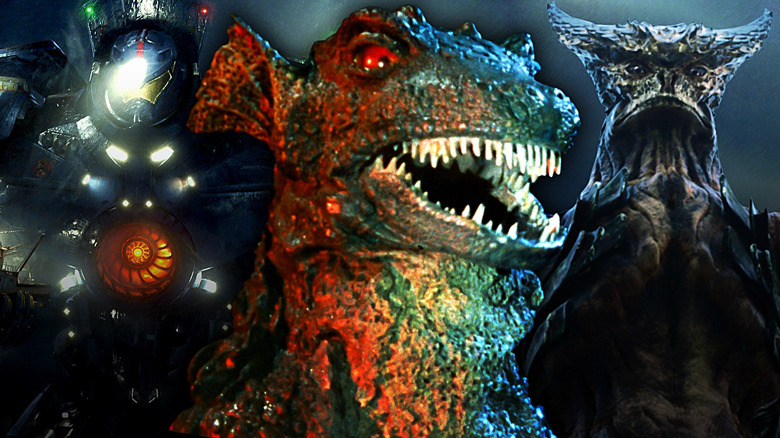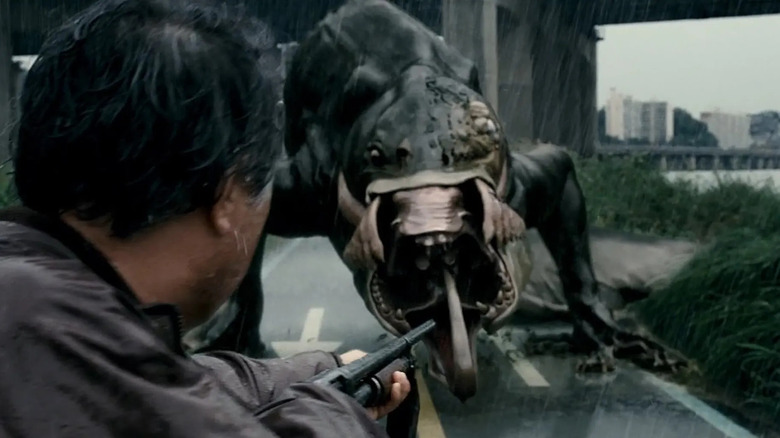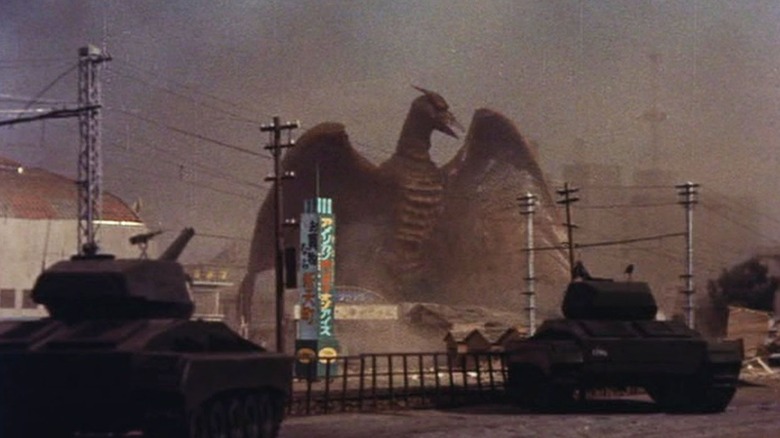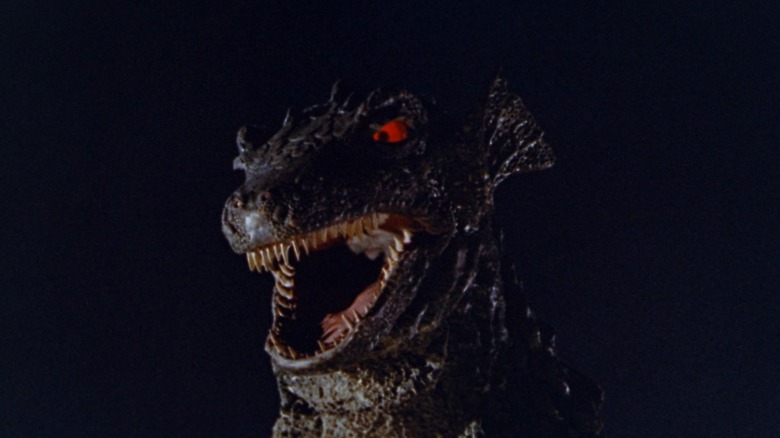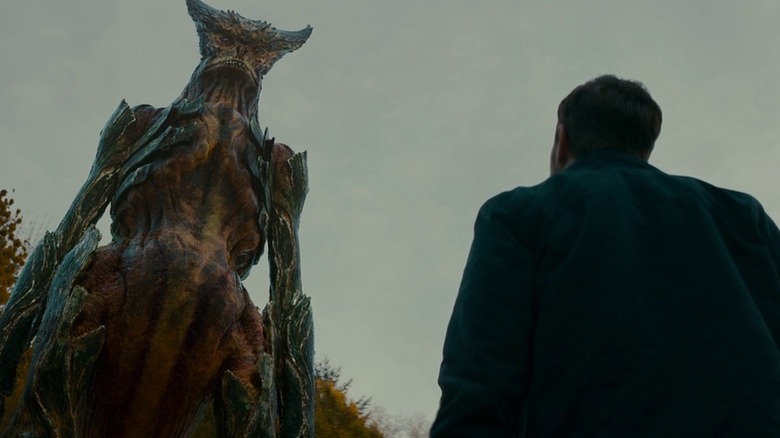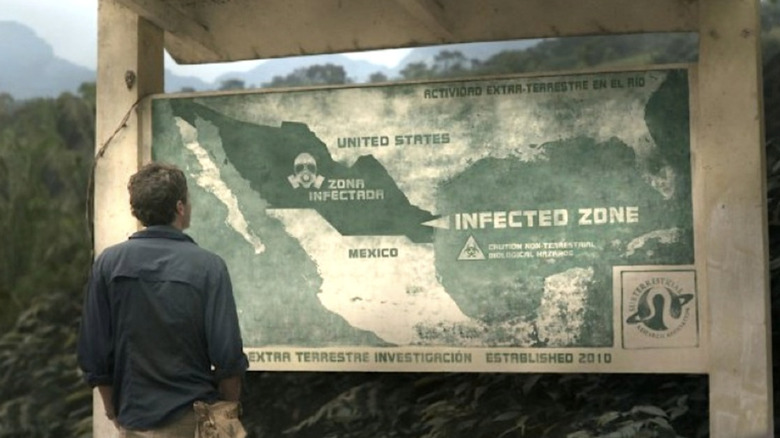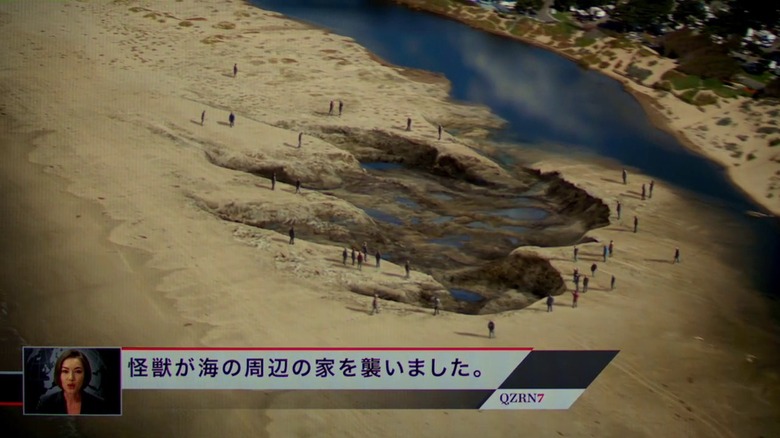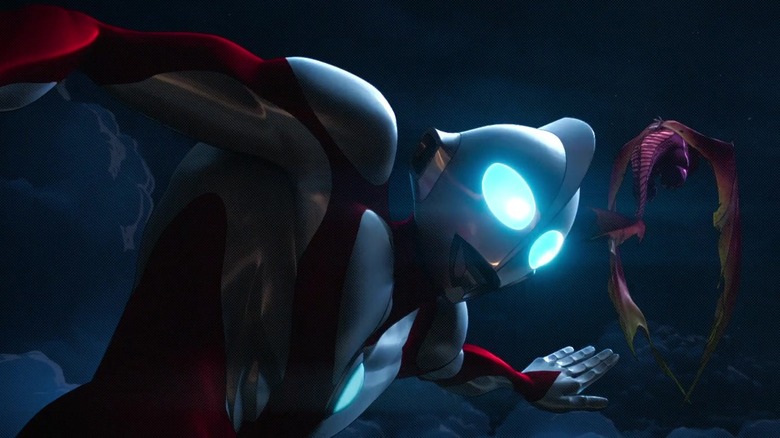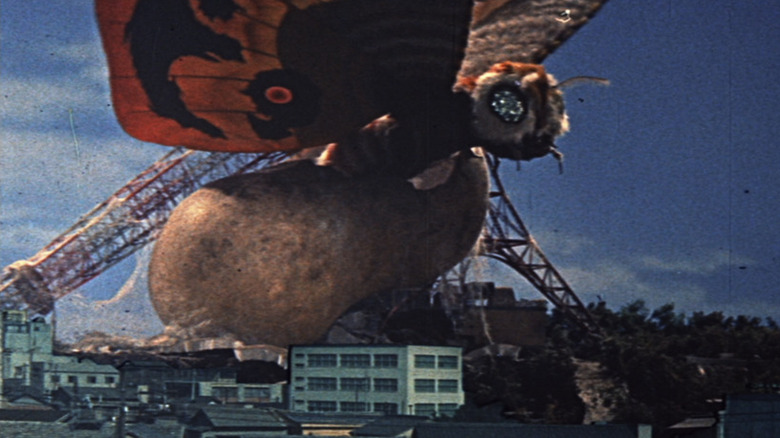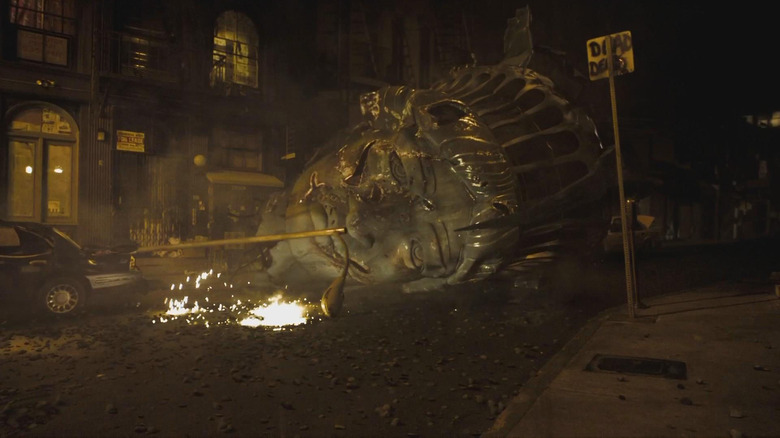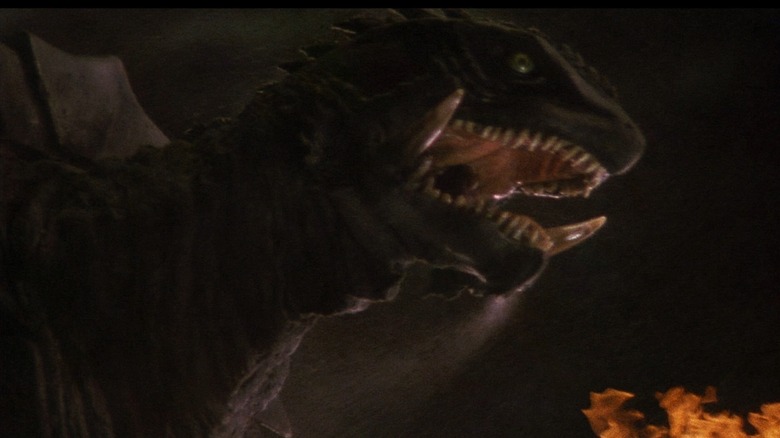10 Kaiju Movies You Need To Watch If You Like Godzilla
Hyperbolic as it sounds, I believe Godzilla's popularity in the 1950s and 1960s opened Japanese pop culture to the world, stomping the door down for Pokémon, anime, Japanese horror, and even Nintendo video games. But in a very direct way, Godzilla also created an entirely new genre: the "kaiju" movie. Translated literally as "strange beast," the kaiju movie (of which there are many great examples) is more than just a "giant monster movie." It's a bizarre yet beautiful (and yes, even sometimes brilliant) blend of creativity and chaos, celebrating the apex of human imagination. It's also just really freaking fun.
Godzilla launched this genre in 1954, and has been "The King of the Monsters" ever since. But if you have made your way through the entire Godzilla franchise, and are feeling a kaiju-sized void in your life, have no fear, you have come to the right place. As an expert on Godzilla, I'm here to tell you that there is no shortage of bizarre Godzilla ripoffs you never knew existed (as well as plenty of Godzilla movies that never got made, but that's another story). But where to begin?
Whether you're a casual kaiju lover or a diehard devotee of monster destruction, let me guide your way through the kaiju movies you need to watch if you like Godzilla. This list isn't just a ranking but rather a celebration of the movies that followed in Godzilla's colossal shadow, while at the same time making a mammoth footprint of their own. Love Godzilla? You need to watch these 10 movies
The Host
"The Host" didn't hail from the "Land of the Rising Sun" but from South Korea, the "Land of the Morning Calm." It's the only South Korean movie on this list, but the country has contributed mightily to the kaiju genre since the glaring Godzilla ripoff from 1967, "Yongary, Monster From The Deep." There's also its brutally boring 1999 remake released in the US as "Reptilian", as well as "D-Wars" with dueling dragons, and a middle-finger flipping King Kong clone in "Ape." Go further north, and there's the truly outrageous "Pulgasari," made by director Shin Sang-ok, who was kidnapped by North Korean dictator Kim Jong II to make a propaganda film against Western imperialism (the irony was lost on Jong II).
Each of those are kinda esoteric and best watched by only experienced kaiju fans, but "The Host" is accessible to entry level fans and even people who "don't like" monster movies. Directed by Bong Joon Ho well before "Snowpiercer," "Okja," and "Parasite," "The Host" tells the tale of a creature created from the chemical waste dumped into South Korea's Han River by careless American military personnel. When the creature kidnaps his daughter, a vendor must cut through bloated bureaucracy to save her himself. Besides being a magnificent monster movie, "The Host" is also a scary horror film, a rollicking satire, and even a heartwarming family film. Little wonder it's considered one of the best kaiju movies, period, Korean or otherwise, and the film that launched Joon Ho's Oscar-winning career.
Rodan
Two years after Ishiro Honda had Godzilla burn a Japanese city to the ground in beautifully bleak black and white, he had a new radioactive reptile do the same in "Rodan." The 1956 movie was Toho Studios' first film that wasn't shot in black and white, and it's telling they introduced color with a kaiju picture. Clearly, they saw a future gold mine in the genre, which they mined throughout the 1950s and 1960s.
Speaking of mines, "Rodan" takes place in a small mining village, and begins as a giant bug movie, with an engineer investigating the grisly demise of his coworkers, finding himself into a volcano. Turns out the giant bugs were only an appetizer (literally) to the main kaiju course, as they are merely munchies for a radioactive pterodactyl and his mate. Now awakened, Rodan wreaks havoc on the village and the nearby big city of Fukuoka, laying waste to the place not with an atomic beam (ala Godzilla), but the sonic boom from his winds.
"Rodan" is an important milestone in kaiju cinema, as it was Toho's first kaiju movie without Godzilla (the sequel "Godzilla Raids Again" was released in 1955). If "Rodan" failed, we likely wouldn't have seen any more non-Godzilla movies and probably significantly less Godzilla movies too. That "Rodan" succeeded meant that the "kaiju cinematic universe" of the Showa Era (which influenced "Godzilla x Kong: The New Empire") would expand beyond Godzilla, while also spearheading a deluge of giant monster movies, both by Toho Studios and others across the world.
Gorgo
"Like Nothing You've Ever Seen Before" boasted the poster of 1961's "Gorgo," despite the fact moviegoers had very clearly seen giant monster movies just like this before. "Gorgo" is unabashedly a Godzilla ripoff, with only a few tweaks distinguishing the titular titans. Most notably, Godzilla is often portrayed as a dude — he's king of the monsters, in the West at least (in Japan Godzilla is an "it") – whereas Gorgo is a gal. More than that, she's a mother –- and a badder mutha' than Shaft at that (shut yo mouth).
Okay, Gorgo's actually a good mother, which drives the plot. An undersea volcano unleashes sea monsters, Gorgo and her child among them. Seeing dollar signs in the giant saurian, greedy sailors kidnap Gorgo's baby, and take the beast back to Great Britain to put on display in an English circus. Bad move, bruv. Mama shows up to lay a whooping on sleepy London town, including cleaning Big Ben's clock. This was a similar premise to Toho Studios' "Mothra," but given that film came out just a few months before "Gorgo" we seriously doubt there was any, um, "creative borrowing."
Also noteworthy is that, as a co-production between the United Kingdom, United States, and Ireland, "Gorgo" doesn't criticize nuclear weaponry but celebrates a mother's love. While there's no denying the movie's source material, "Gorgo" still stands on her own two feet as one of the best of the blatant Godzilla ripoffs.
Colossal
Since Godzilla first showed his scaly skull on the mountains of Odo Island in 1954, the kaiju genre has been rife with social commentary. Mostly it's been deployed as a criticism of corporate greed ("Mothra," "King Kong vs. Godzilla"), environmental degradation ("Godzilla vs. The Smog Monster"), and the atomic bomb/nuclear proliferation (pretty much every Godzilla movie ever). "Colossal" may be the only kaiju movie I'm aware of that doubles as a satiric swipe at massive male insecurity masking itself as toxic masculinity, and female liberation from the same (unless you want to take a super-pretentious reading of "King Kong," but I don't). So the kaiju genre by way of gender studies?
Anne Hathaway stars as out-of-work party gal Gloria, who is kicked out of her New York apartment by her boyfriend Tim (Dan Stevens) and goes back to her hometown of Mainhead, New Hampshire. There, she runs into the arms of "the one that got away," Oscar (Jason Sudekis), the smalltown bar owner who never left. Before you can say, "Wait, that's a Hallmark movie," Gloria discovers that when she plays in a sandbox, she controls a killer kaiju in Seoul, South Korea.
That should be enough to sell you on "Colossal" right there, but trust me when I say the movie is even better than its premise (I just really don't want to spoil it for you). Do yourself a favor and check out this criminally under-seen black comedy, horror hybrid, kaiju flick as fast as you can.
Monsters
Gareth Edwards had an unenviable task (okay, actually, I'm very envious): Bring back the most famous movie monster ever for a franchise relaunch that satisfied the fanbase and series' owners Toho Studios, all while also washing the stain away of Roland Emmerich's "Godzilla" (dubbed "GINO" or "Godzilla In Name Only" by haters). The fact that Edwards got the "Godzilla" (2014) gig after having only directed one movie is incredible, unless you have seen the movie that landed him the job, "Monsters."
Okay, so the title isn't exactly original, but it disguises the unique premise. A NASA spaceship brings back an alien organism that crash lands in Central America, releasing a kaiju epidemic that quarantines most of Mexico. But that's just the backstory; the main story follows a jaded journalist named Andrew (Scoot McNairy) as he escorts an American tourist named Sam (Whitney Able) through the infected zone back to the border. Along the way they get to know each other in a budding relationship drama that at times feels like Richard Linklater's "Before" trilogy ... but with monsters.
There's a well-worn trope that moviegoers don't care about the human characters, only the monsters, which isn't true in the slightest (see "Godzilla Minus One" as a clear counterpoint). "Monsters" shows Edwards and his cast deftly balancing human drama (the talking parts) with compelling kaiju action that convinced studio heads that the indie director was ready to bring The Big G back to the big screen.
Pacific Rim
Few filmmakers fanboy harder than Guillermo del Toro (yes, I did just use "fanboy" as a verb, what about it?). Never has del Toro flown his fanboy flag higher than "Pacific Rim." Sure, he was probably grinning with glee while making "Hellboy II: The Golden Army," but he was adapting someone else's work (Mike Mignola). "Pacific Rim" rose from the depths of del Toro's bountiful imagination, and it bears his monster-sized footprint every bit as much as his more high-falutin films like "Pan's Labyrinth," "The Shape of Water," and "Nightmare Alley."
Most of "Pacific Rim" takes place in 2025, a decade after legions of monsters conveniently called "kaiju" arrive from an alternate dimension through a portal in the Pacific ocean. Humanity has decided to fight the kaiju not with drones, bombs, missiles, or chemical warfare, but the right and proper way: by building giant mechs called Jaegers to whip some kaiju tail. Under the leadership of Idris "the apocalypse is cancelled" Elba as Marshal Pentecost, and Charlie Hunnam as washed-up pilot Becket, humanity makes its final stand (well, until the sequel) against the monsters. If that sounds a bit much, the biggest stretch is casting Charlie Day as a brilliant scientist (we kid, we kid).
"Pacific Rim" is everything a kaiju movie should be, a childlike celebration of chaos and calamity where robots fighting monsters somehow makes perfect sense. Frankly, the film feels like a kid smashing toys together, and that's what I love about it.
Ultraman: Rising
After years spent directing the special effects for Toho's motley crew of monsters, Eiji Tsuburaya founded his own company in the early 1960s. Its centerpiece was franchise star "Ultraman." The red-and-silver, pointy-headed hero who battled kaiju would star in his own TV series, followed by multiple spinoffs, sequels, and remakes on both the big and small screens. In fact, Ultraman comes close to matching Godzilla's record for the most movie appearances (37 to 38), though many Ultraman movies are compiled from TV episodes.
Despite Ultraman's popularity rivaling Godzilla's in their home country, the character hasn't connected as much with Western audiences. If that starts to change, it'll be because of the absolutely splendid animated film "Ultraman: Rising." Released on Netflix in 2024, "Ultraman: Rising" is a case study on how to successfully reinvent a classic franchise for new audiences. It tells the story of Ken Sato, a superstar baseball player whose dad just so happens to be Ultraman. Sato returns to Japan to take over for his old man, while stilling play pro baseball ... and while raising a baby kaiju, who is the infant of his greatest adversary. I'm sure parents can relate.
If you ever wanted to see a kaiju flick with the spirit of a Pixar classic, "Ultraman: Rising" is for you. I love it so much, I'd even recommend it to people who don't like Godzilla, though I usually avoid those people. Who needs that sort of negativity?
Mothra
Godzilla's rogues gallery includes a golden, three-headed space dragon (Ghidorah), a claw-handed alien cyborg with a saw in its belly (Gigan), and a demonic crustacean that looks like he was born in the bowels of hell (Destroyah). Yet one of the toughest, most prolific, and popular characters is a giant moth. But hey, they don't call Mothra "the Queen of the Monsters" for nothing.
What makes Mothra so continuoulsy popular is her personality. In the kaiju alignment chart, she's a "Lawful Good," profoundly committed to protecting the people of Infant Island, her simultaneously talking tiny twin priestesses, the Shobijin, and especially her egg and larval offspring, (okay, sure, and on occasion human beings too), even to her dying breath. And yes, she has died many, many times before, almost as much as Sean Bean.
Only a few Toho characters have gotten their own solo film separate from Godzilla, let alone a whole trilogy, and Mothra was one of them. Her story started with her 1961 self-titled debut film. When a greedy businessman kidnaps Mothra's fairy priestesses from their island home, the mythical moth monster deity makes a "bee"line for Japan to rescue them. Okay, yes, Mothra does some collateral damage, but she does it for the greater good. Besides, human beings started it.
Mothra is Godzilla's favorite frenemy, appearing in 12 of Godzilla's films. But to truly experience what makes Mothra a magnificent character in her own right, you have to check out her inaugural adventure.
Cloverfield
Teaser trailers don't come much more impactful than "Cloverfield." Debuting before "Transformers" in the summer 2007, we see home movie footage showing a bunch of carefree 20-somethings blithely living the life in the big city of New York. But then their revelry is interrupted by a loud noise, followed by an explosion. Finally, we're on the street running with them as a giant object hurls across the sky. When it lands, we see what it is — the severed head of the Statue of Liberty. Cut to black. Pretty cool, yeah?
Moviegoers naturally thought they were seeing the announcement of a new Godzilla movie, but it was actually the first teaser trailer for Matt Reeves' "Cloverfield." Though the final film didn't quite live up to the promise of the trailer, that says less about the movie, and more about the trailer (it was really good).
"Cloverfield" is a typical kaiju flick (monster attacks city), but follows an atypical approach: Using the found-footage concept popularized by "The Blair Witch Project" (and deployed later by "Paranormal Activity"), "Cloverfield" charts the journey of young New Yorkers (including a "before they were famous" Lizzie Caplan and T.J. Miller) through the monster's destruction. Sure, Reeves does get a little too cute with some of the scenarios (you may want to scream, "Just drop the camera already!"), but "Cloverfield" is a clever take on the kaiju picture. Just be sure to have a puke bag handy if you're prone to motion sickness.
Shusuke Kaneko's Gamera Trilogy
A giant, fire-breathing turtle who spins around like a flying saucer and is a friend to all children does not sound like the ingredients for an excellent movie series. A kitschy crap-show you might love as a kid (or as an adult under the influence of something), sure, but not "good." Gamera was Toho's rival studio Daiei's answer (*cough* flagrant ripoff *cough*) to Godzilla: a terrifying, titanic terrapin who battles a laser-shooting vampire bat, a knife-headed alien attack dog, and a killer shark from space, among others. The Showa "Gamera" movies are a blast, to be sure, but very much targeting the under-13 crowd (and immature adults like myself). That changed with Shusuke Kaneko's "Gamera" reboot in the 1990s.
Nobody would have blamed Kaneko for making a silly kid's movie. Instead, he made not one, not two, but three certifiable kaiju classics: "Gamera: Guardian of the Universe," "Gamera II: Attack of Legion," and "Gamera III: Revenge of Iris." Reimagining Gamera as a bio-weapon developed by an ancient civilization to protect the planet (specifically Earth's life force), Kaneko's Gamera is not the cute and cuddly critter from the 1960s and 1970s Showa Era. He's a cold-blooded killer who takes as much punishment as he gives, and he will stop at nothing to complete his mission. It's essentially The Doom Guy, but 200 feet tall and with a shell. Point blank, you have to check out Shusuke Kaneko's "Gamera" trilogy if you love Godzilla.
